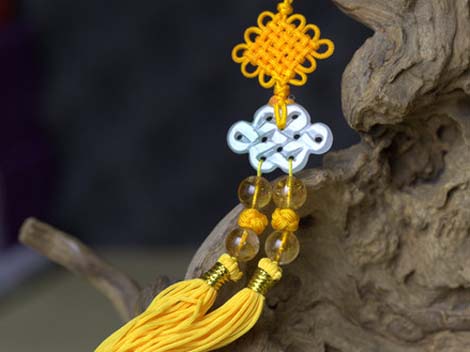
With the advancement of civilization, Chinese people used knots for more than just fastening and wrapping. Knots were also used to record events, and some knots had purely ornamental functions. In 1980, some dedicated connoisseurs collected and arranged the decorative yet practical knots that have been passed down through the centuries in China. After studying the structures of these knots, the devotees set about creating new variations and increasing the decorative value of the knots. These exquisitely symmetrical knots which come in so many forms are as profound as the great cultural heritage of the Chinese people. The knots have thus been collectively named Chinese Macram.
Chinese Macram is based on over a dozen basic knots that are named according to their distinctive shapes, usages, or origins. For example, the Two Coins Knot is so named because it is shaped like two overlapping coins of the kind once used in ancient China. The Button Knot can actually function as a button. The basic form of the Pan-ch'ang Knot, which is actually a series of continuous loops, symbolizes the Buddhist conception of continuity and the origin of all things. Indeed, the Pan-ch'ang Knot is the primary knot of Chinese Macram upon which an endless number of variations can be made.
Chinese Macram, like Chinese calligraphy, painting, porcelain, and even Chinese cooking, is easily recognizable to admirers of the Chinese culture. This is because the basic structures of Chinese Macram cause it to differ greatly from Western or Japanese Macram in shape and function.
The knots of Chinese Macram are pulled quite tightly. They do not easily come undone when used to bind or wrap something, so they are very practical. Furthermore, the complicated structure of Chinese Macram allows for all kinds of variations and enhances its decorative value. Almost all the basic knots of Chinese Macram are symmetrical in form. While the demand for symmetry has set certain technical limitations on the design and creation of new patterns and themes, symmetry is consistent with time-honored ornamental and aesthetic standards in China. Visually, the symmetrical designs are more easily accepted and appreciated by Chinese people.
Except for the Two Coins Knot, Chinese Macram is three dimensional in structure. It is comprised of two planes which are tied together to leave a hollow center. Such a structure lends rigidity to the work as a whole and keeps its shape when hung on the wall. The hollow center also allows for the addition of precious stones.
Crafting Chinese Macram is a three-step process of tying knots, tightening them, and then adding finishing touches. Knot tying methods are fixed, but the tightening can determine the degree of tension in a knot, the length of any loops (which are called "ears" in Chinese), and the smoothness and orderliness of lines. Thus, how well a piece of Chinese Macram has been tightened can demonstrate the skill and artistic merit of a Macram artist. To finish a knot means inlaying pearls or other precious stones, starching the knot into certain patterns, or adding any other final touches.
Since ancient times, Chinese Macram has decorated both the fixtures of palace halls and the daily implements of countryside households. Chinese Macram has appeared also in paintings and other pieces of folk art. For instance, Chinese Macram was used to decorate the chairs used by the emperor and empress, the edges of parasols, the streamers attached to the waistbands of lady's dresses, as well as all kinds of seals, mirrors, pouches, sachets, eyeglass cases, fans, and Buddhist rosaries.
The endless variations and elegant patterns of Chinese Macram as well as the multitude of different materials that can be used (cotton, flax, silk, nylon, leather, and precious metals such as gold and silver) have expanded the functions and widened the applications of Chinese Macram. Jewelry, clothes, gift wrapping, and furniture can be accentuated with unique Chinese Macram creations. Large wall-hangings made of Chinese Macram have the same ornamental value as fine paintings or photographs and are perfectly suited for decorating any room.





